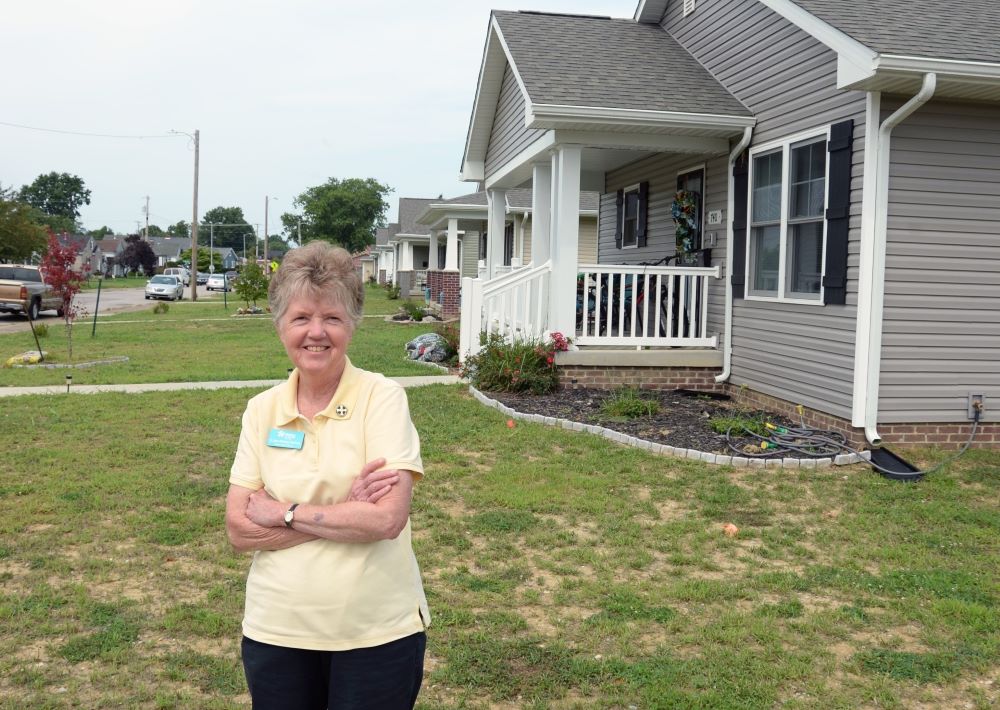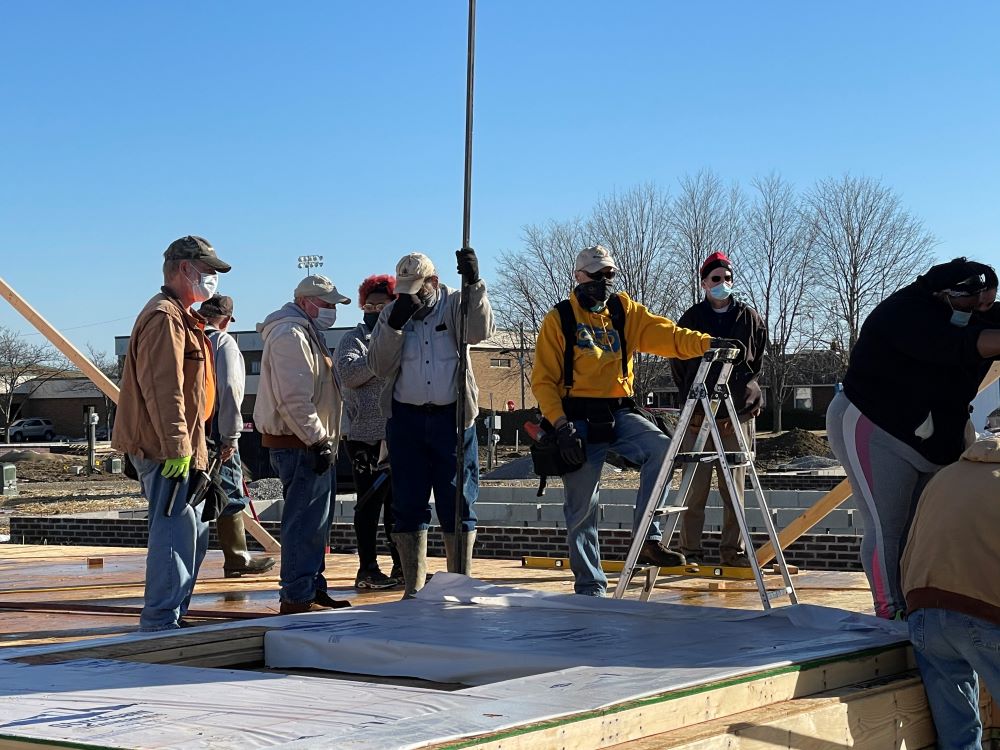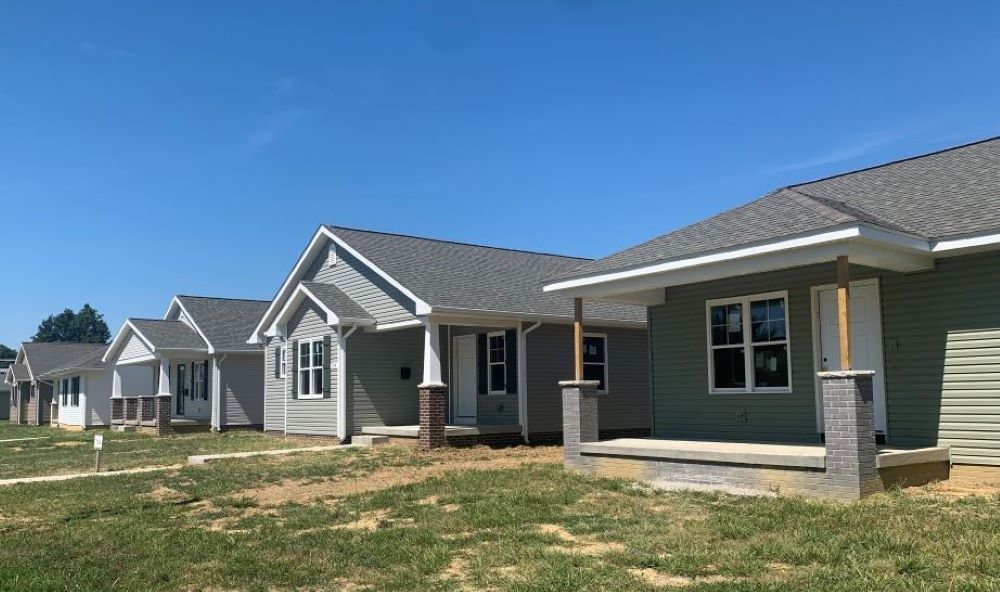
Benedictine Sr. Jane Michele McClure poses outside a Habitat for Humanity of Evansville house. McClure, major gifts officer at Habitat, suggested the organization work with members of a closed parish to build homes on the church's site. (Courtesy of Habitat for Humanity of Evansville, Indiana)
Flip through the archives of a town's newspaper, and a community's history reveals itself. When that community is a Catholic parish and school, the entirety of family life can play out on those weathered pages.
So it was that on a cloudy and windy day in Indiana, in early April 1950, the society pages of the Sunday Evansville Courier & Press were filled with dozens of announcements about upcoming weddings. In the lower left-hand corner on the cover of the paper's "B" section, a young Betty Titzer smiled as three short paragraphs announced her immediate future.
"Mr. and Mrs. A. L. Titzer of Whetstone Road are announcing the engagement of their daughter, Betty, to Richard Eugene Miller … "
The wedding was to take place on a Saturday in May at St. Theresa's Catholic Church. Betty's 1950 marriage was the first of countless Titzer family events that took place in and around the church.
"It goes back to my aunt and uncle. My aunt was the first organist at St. Theresa, and they (Betty and Richard) were the first couple to be married at the new church building," said Steve Titzer, Betty's nephew. "My grandfather was one of the charter members of St. Theresa's, back in the 1940s."
In those days, St. Theresa's first goal was to raise money for a school. Archives show Fr. Cornelius Sahm started organizing a fund drive for $50,000 in the spring of 1948. Parishioners attended Mass in a Quonset hut, before the school, gym and church buildings were completed.
From baptisms to confirmations, weddings to funerals, "there's a long history at St. Theresa's with my family," Steve said.

Former members of St. Theresa's Parish in Evansville, Indiana, eagerly contributed resources to help build St. Theresa Place, a Habitat for Humanity project. A total of 14 homes were built on the site of the former parish, school and convent. (Courtesy of Habitat for Humanity of Evansville, Indiana)
So what happens when that history meets an unplanned and abrupt end? How do followers continue to fashion God's kingdom, when the very spaces that helped create those believers are shuttered?
One woman had an idea.
Benedictine Sr. Jane Michele McClure thought that even though the physical structures were slated for demolition, there just might be a way to strengthen the St. Theresa community, with buildings of an entirely different sort.
Winds of change
It was the early 2010s, and Catholics in southwest Indiana, like in other areas of the country, were not attending Mass as regularly as had once been the norm.
According to a March 2024 Gallup poll, the number of U.S. adults attending any religious service weekly dropped from 42% nationwide in 2000-03 to 38% by 2011-13. For adult Catholics, the drop in that same time period was from 45 to 40%.
In Evansville, the decline in church attendance, coupled with a priest shortage, meant that in 2013, the diocese consolidated 24 parishes into just 10.
St. Theresa's Parish and School did not make the cut.
"There are still people who are upset about that," Steve Titzer said.
"A house dedication is liturgical, spiritual. People walk away from a dedication and they say, 'This is the experience of the Kingdom of God. This is how it's supposed to be.' "
—Sr. Jane Michele McClure
Former parishioners explain that part of the reason for that lingering sense of loss is because of the people who came together to create that community of faith — inside and outside the church.
Luan Greubel, 76, grew up Catholic, attending church and parochial school through her high school graduation.
At the time, it was a responsibility, not a relationship, she said.
"I went to church, but I wasn't really committed, I didn't feel like I was part of the group. I'm sure a lot of Catholics, or people of any faith, have felt that way," Greubel said.
As an adult, Greubel went to work for Whirlpool, working her way from her start as a typist, into a college degree that ultimately helped her move up the company's corporate ladder. That degree enabled her to buy her first house in a neighborhood that wasn't too far from St. Theresa's.
And that, Greubel said, changed everything.
"I walked into St. Theresa's, and it was like an experience I've never had. It was awesome.
"I call it like it was Camelot. We had a charismatic priest, and he had a team that worked at the parish that matched his energy. We were a faith community, but it was more than that. Father Ted (Tempel) had this mission. He expected parishioners to do things, that stewardship be shown through time, talent and treasure."
That "requirement" fostered a tight-knit community.

The 14 houses at St. Theresa Place in Evansville, Indiana, feature covered front porches and brick foundations, designed to help the homes resemble the existing World War II-era homes in the neighborhood. (Courtesy of Habitat for Humanity of Evansville, Indiana)
"I ended up going to St. Theresa's for 30 years," Greubel said. "A lot of people went there, their children grew up there, got married there. There was a closeness, because we all looked out for each other. If somebody was on hard times, everybody came together to support them. We felt each other's sadness and grief, but we celebrated together too.
"It was just an unbelievable community."
Finding peace
McClure has firsthand evidence of the unique spirit at St. Theresa's.
"There was a lot of community there, a lot of generous service that was done," McClure said.
As a member of the Sisters of St. Benedict, McClure lived with other members of her congregation at the parish convent. That proximity gave her an eyewitness view to nearly everything happening in the parish community, including the news of its closure.
"The decision to close certain parishes, to merge certain parishes, it was preceded by a lot of study and discussion," McClure said. "What was happening in Evansville, Indiana, was something being replicated all over the country.
"Still, when it came time to close St. Theresa, I knew a lot of the people and how it was so very difficult."

Benedictine Sr. Jane Michele McClure (Courtesy of Habitat for Humanity of Evansville, Indiana)
McClure said that the school closing was probably less of a surprise.
"The school population was less than 100, those numbers alone were telling them that was not viable anymore," she said.
But the parish itself was another matter altogether.
"They felt like they had a vibrant, active parish."
McClure, major gifts officer for Habitat for Humanity of Evansville, started brainstorming with some of her colleagues.
"I felt like the people of St. Theresa's Parish were in mourning, they had lost their parish home, and they needed a way to work through this."
Making good
So McClure and her colleagues assembled a team of "doers" whose motto was, "We work together, we worship together, we play together."
The goal: replace the church buildings with Habitat homes.
The team was all in.
They canvassed the neighbors that surrounded the former parish and school site to talk with them about the idea. From house to house, team members fanned out, inviting home owners to meetings to discuss their concerns. McClure's team knew it was critically important to get families around the would-be Habitat site to support the build.
They got it.
One of the members of the Habitat team, Fr. Ted Tempel, the former pastor at St. Theresa's, helped drive the project mission home, so to speak. Tempel served for 14 years with the parish. When he heard the project was designed to build 14 homes on the parish grounds, he made the connection between the number of years he served and the number of homes that were planned.
"He said, 'One house for every year of my ministry,' " McClure said. "People started crying, he cried, I cried, and that was it. Battle done."
Habitat experts worked with the neighbors to design homes that were nearly identical to the WWII-era and earlier houses that lined the streets around the former church and school.
"The design of (the new Habitat homes) fits in with the neighborhood. Porches, brick foundations … the existing houses were all well-maintained and well cared for," McClure said. "We wanted to be sure to add those touches."

A drone image shows St. Theresa Place in mid-build in Evansville, Indiana. Habitat for Humanity broke ground on the project in August 2020, and the 14th and final homeowner received their keys in January 2022. (Courtesy of Habitat for Humanity of Evansville, Indiana)
When Steve Titzer and other anchor families heard about the Habitat plan, they knew right away it was the exact right thing to do with the land.
"Serving people with affordable housing, providing that service to the community, was an idea that went over well," Titzer said. "People said, 'Oh, that's a great idea, something we can all be proud of, for what St. Theresa's became.' "
The sponsorships for the 14 houses came almost immediately, Titzer said.
"If we'd had 20 plots, we would have sold them like that," he said.
Habitat for Humanity broke ground on the subdivision, called St. Theresa Place, in August 2020. Habitat dedicated its first home in St. Theresa Place in June 2021. The 14th homeowner received the keys to the subdivision's final house in January 2022.
Titzer points to the mission of Habitat, "seeking to put God's love into action," to help explain why it was so easy to rally the St. Theresa alumni.
"In church and at school, there were always discussions about helping people, being generous of spirit and giving back," he said. "That makes it different when you hear it all the time."
Advertisement
The words are more than words, Titzer said, they become a subconscious mantra.
"So when the Habitat project is proposed, and you think about St. Theresa's legacy of community spirit, it's easy. We as a parish utilized that piece of property to educate and formulate attitudes in Christian beliefs.
"We gained so much from that experience, and we have given it back."
McClure couldn't agree more.
"Habitat's focus is on action, to demonstrate the love of Christ," McClure said. "When you think about a house dedication, there's always a mix of those who have material resources and those with limited resources. It's always a mixture of races, people of different faiths or no faith, people with advanced education and those with very little. But a house dedication is liturgical, spiritual.
"People walk away from a dedication and they say, 'This is the experience of the Kingdom of God. This is how it's supposed to be.' "








